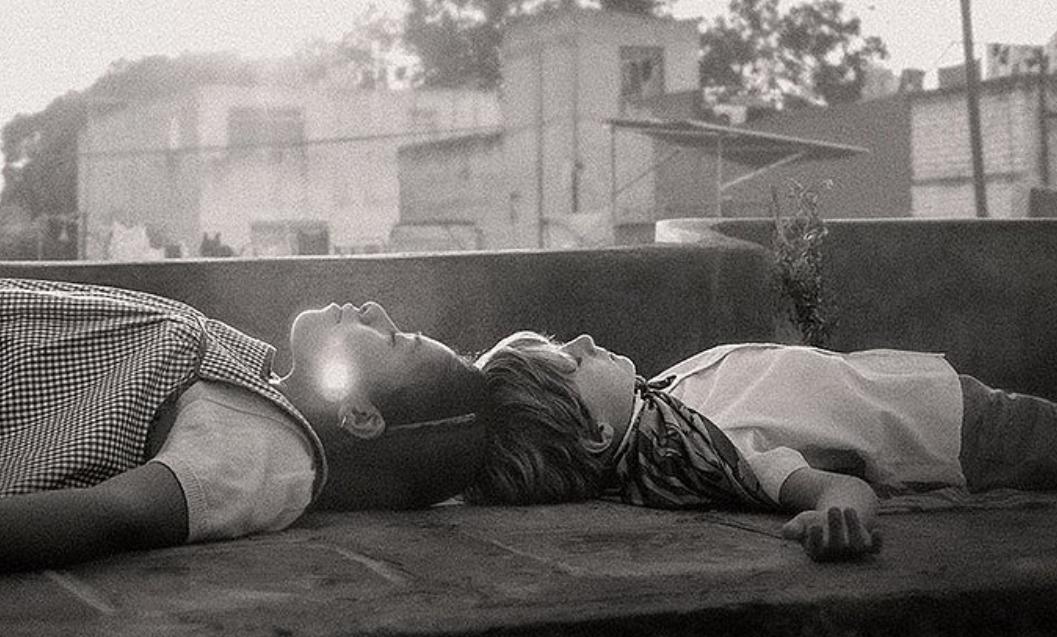Now this is a movie. Roma is an astonishing achievement, a ravishing feast for the ears and the eyes that shows the best that cinema can do. Telling the story of a housekeeper in Mexico City during the early 1970s, it combines the personal and the political to devastating effect. This is not only Alfonso Cuarón’s best film, but easily the best film of the year.
Roma creates an entire, fully-realised world here; putting more effort into each shot than some directors put into entire movies. With a style that brings to mind directors as diverse as Béla Tarr, Federico Fellini and Mikhail Kalatozov, Roma really is a sublime work of art.
Yalitza Aparicio, in her debut role, plays Cleo, who keeps house for a middle-class family. Much attention is given to her housework, whether its folding clothes, scooping up dog-shit, dressing the kids for school or fixing a drink for the Matriarch Sofía (Marina de Tavira). Sofía is married to Dr Antonio (Fernando Grediaga), who is introduced driving a massive car that can barely fit in the doorway: a smart metaphor for their strained marriage. Meanwhile, Cleo strikes up a relationship with martial-arts enthusiast Fermín (Jorge Antonio Guerrero), which seems to go swimmingly until Cleo realises she’s three months late. All told against the dense political backdrop of Mexico in the early 70s, the resulting tale is a masterpiece in every sense of the word.
This is as personal as it gets. Cuarón not only wrote and directed the film, but co-produced it, co-edited it and served as his own cinematographer. Shot on an Alexa 65 and using an 2.35:1 aspect ratio, the frame is simply massive, wielding an enormity of depth that brings to mind epics such as Lawrence of Arabia. For example, one shot shows a Martial Arts guru on the side of a cliff doing a demonstration with the city in the distance, then in the corner, far, far away, somebody is putting their washing up. You could watch the film ten times and not catch everything that is going on. It’s the kind of film you might need to watch twice – first to simply marvel at the images and second to catch up on the subtitles. It really had to be in black-and-white, as its the only way to keeps the images clear even when there are a hundred things going on at once. One looks at the choreography – especially involving kids under the age of ten – and thinks: How on earth did he do all that?
https://www.youtube.com/watch?v=fp_i7cnOgbQ
The surround system is equally sublime, simulating action not seen on the screen, giving the film a transportive, immersive feel. For example, if a character talks off the right of the screen, we hear her from the right side of the theatre. Roma takes sound to its full symphonic capability – expertly mixing the sounds of cars beeping, helicopters circling, dogs barking, women crying and even the odd gun going off. In fact, no film before has ever quite recreated the sensation of walking through a busy city street, fully aware of the sheer infiniteness of the world around you. Crucially, there is no non-diegetic sound; the soundtrack is Mexico itself.
As a result of both its sound and images, it has to be experienced in a cinema or with the best screen and sound system combination available. It’s not that it won’t be the same experience on your laptop or a phone, it simply won’t be the same film. Let’s hope Netflix – who have rebranded their opening logo to a single stylish “N” here – makes sure it gets a traditional release.
The hard part in telling a story like this is by making sure that its central protagonist doesn’t get swept away by all the surrounding grandeur, yet Roma makes sure to prioritise the smaller details too, especially Cleo’s own interiority. As if to introduce the intimate yet epic scope of the movie, the long-opening shot is of the floor with water washing over it, finally revealing the reflection of a plane flying overhead. Then, once we get to the inevitable Christmas scenes, they are shot with such warmth that they recall Bergman’s classic Fanny and Alexander. Perhaps the supporting cast aren’t as three-dimensional as they could be, yet this is cinema of gesture – characters are not so much people in themselves than stand-ins for something bigger than themselves.
To be honest, I feel little need right now for conventional analysis of themes and character or to explain the historical background to the tale (which is always present but never full explained). As simply something to marvel at, this is cinema at its best. Go see it on the biggest screen you can.
Some of the coverage you find on Cultured Vultures contains affiliate links, which provide us with small commissions based on purchases made from visiting our site.

